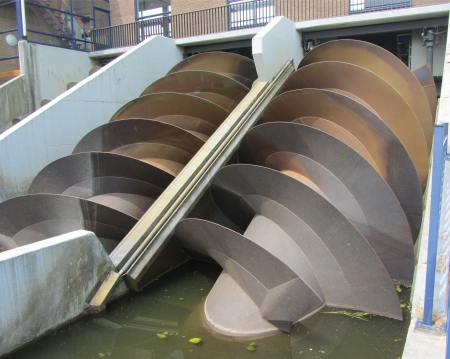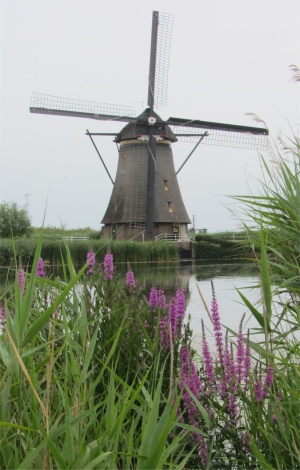
Windmill and Wild Flowers
|
Nowhere else in the world is there such a high concentration of windmills in authentic Dutch "polder" countryside. Kinderdijk has become one of Holland's most iconic sights. The unique character of the 19 mill Kinderdijk windmill-complex has been listed as a UNESCO world heritage site since 1997. The milling complex consists of 8 stone brick windmills of the water board Nederwaard which were built in 1738, 8 thatched windmills of the water board Overwaard built in 1740, 2 stone windmills of the polder Nieuw-Lekkerland built in 1760 and 1 windmill of the polder Blokweer which was built in 1521 and burned down in 1997. Since that day the windmill has been restored and has been operational since the spring of 2000.
At the entrance to the site, a modern diesel pumping station with three impressive, huge Archimedes screws provided the means of removing water from the reservoir to the river Lek. Near this pumping station stood a backup system, and a little beyond that stood the old pumping station. This served as a visitor's centre, where a short film show among the still intact old, massive impellor pumps gave an insight to the history of the Kinderdijk, water management and the resulting effect of peat shrinkage due to water removal. Apparently 25% of the Netherlands of today consists of land below sea level, a significant part of which is situated up to approximately 7 meters below sea level.

Museum Windmill Blokweer - Storm Clouds Gathering
|
We took a walk down by one of the canals where some of the mills stood. It became apparent that some of the mills were now lived in. It was almost like walking back through time, indeed if it were not for the dozens of other sightseers I could have slipped into a dreamy world of peasants going about their daily business tending to their polders and ferrying their wares along the canal side paths. We crossed a bridge crowned by a group of lads egging each other on to jump in the canal. At a bend in the canal we visited a cap mill, the Museum Windmill Blokweer, next to the waters of the low canal "Lage Boezem", where we could look around a typical single floor living space.
Working and living in a windmill was never easy, life was hard and poor. The millers used to have large families, 10-12 children were common. There are several reasons for these large families: the influence of the church, no birth control, children often died in their first years and the more sons, the more labour could be accomplished in the mill and the surrounding land. Such circumstances caused the millers to become self-supporting, and they would grow their own vegetables and have their own livestock. Besides that they also did a lot of fishing. When the water is moved, the fish get moved too, and the fishing was facilitated by putting a net behind the scoop wheel. A few nets were hanging outside the mill we were visiting, and had been used to catch eels, tench and other fish. We had noticed the low door opening when entering the mill. In the early days the diets of the inhabitants of the windmills were not well balanced, causing the people to have stunted growth, which in turn resulted in low door openings.
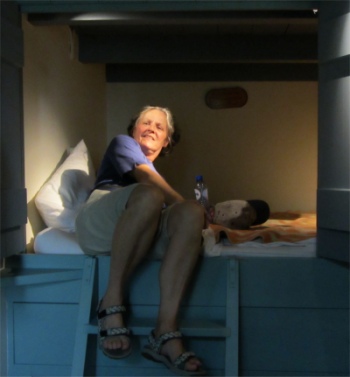
Meryl Trying out Windmill Blokweer Bed
|
A sudden squall had got up by this time, and rain was pelting down. We lingered for a while, giving us a chance to chat with one of the friendly volunteers that ran the mill. The lady informed us that the land was still dropping by a centimetre each year. The local houses were built on piles, but the streets and surrounding land continued to drop. This resulted in steps being added between the streets and houses. The continual land settlement also played havoc with her garden.
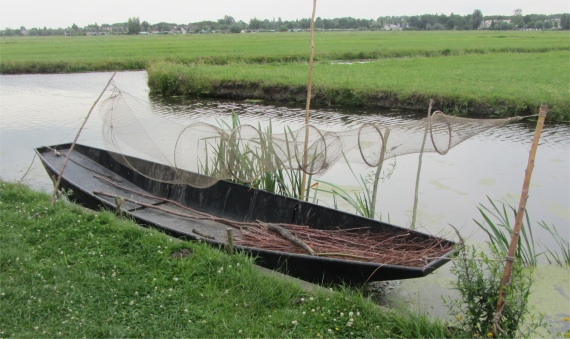
Fishing Net with Polder in the Background
|
With a gale now blowing and a noticeable drop in temperature, we bravely ventured back along the path and stopped off at another mill, Museum Windmill Nederwaard. This was a taller mill and was actually working. Indeed the sails were spinning around at a rate of knots in the current wind. The strong power contained within these rotating sails was tangible and humbling. On the ground floor of the windmill was the under wheel, part of the mill's mechanism. On either side of it was the living room. This room was a multifunctional room: a living room, a kitchen and the bedroom for the two parents and the youngest children. Only the first two floors were heated! The bedrooms for the older children were located on the second floor. The beds were the so called closet beds, and were about 1.60m long. The shortness of the beds had nothing to do with the short people, but more to do with the people being afraid of dying when lying down to sleep (dead people mostly lay down). The doors in front of the closet beds kept them warm in winter time, when it was freezing. The next floor was called the smoke attic. After the miller went out fishing, he would smoke his fish here. That's the reason why the windmill has black walls on the third floor. The chimney also ends here, in the middle of the mill. A normal house has a chimney on the roof, but the sparks from the open fire might set the thatched roof on fire. The fourth floor was called the grease attic. This was the place where most of the mechanism of the windmills reside, containing such components as the brake, the upper wheel, the rollers where the top floor turns on and the king shaft. The top floor of the windmill was not fixed and could be rotated a full 360 degrees. The thatched roof easily catches fire from sparks which are caused by braking and stopping the windmill. To prevent this from happening thick wooden plates were attached against the roof above the braking shoe. I felt the vibration of the rotating sails on this floor, an awful amount of energy was being harnessed today. Below the mill its paddles were actually scooping up water from one level to another.
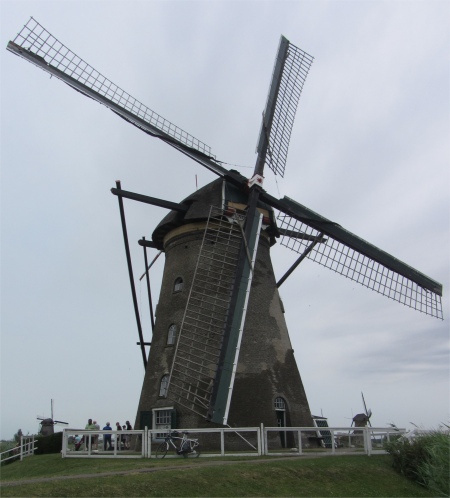
Museum Windmill Nederwaard
|
By now, a gale was blowing across the low lands, and the dark skies looked ominous. We had had a most enjoyable day at the Kinderdijk, but it was now an opportune moment to head back to the Driehoeksveer ferry terminal. A ferry across the Lek to Krimpen ann de Lek also ran from here. A long line of cars waited patiently for this ferry to return from Krimpen, and as soon as the ferry arrived full of cars, another batch boarded and off it went. We watched this ferry cross and return again, and the wind was so strong that it started to blow the vessel sideways into the pilings. It took a wee while for the captain to regain control of his vessel. Meanwhile cars were still continuing to drive off the ferry. The conductor was haring around like a madman trying to collect his fares.
Two Japanese looking ladies joined us in the tiny shelter where we had sought refuge from the howling wind. They were doing a European tour for the second year running, and actually lived in Los Angeles. They were fascinated by the fact that Rex and I had brought
Duonita over from England, but Meryl had chosen to come by ferry. They were based in Rotterdam at the moment, and had caught the tourist ferry which dropped them straight off at the Kinderdijk. They must have forgotten where it had dropped them off since they watched their boat arrive, pull in a short distance up the Lek, far enough in fact that they would have missed it even if they had sprinted up the road. Understandably they were most concerned since that was the last tourist ferry back to Rotterdam. We explained they could catch the fast waterbus to Rotterdam on the Noord, and we would take them to its departure point at Ridderkerk. They were ever so pleased this option was available to them. Our small ferry arrived to convey us to Ridderkerk, and as we motored across the choppy waters, I could only marvel at how some of the large barges could seemingly perform a "hand brake turn" when they abruptly changed direction as they turned right from the Noord to the Lek.
No sooner had we alighted at Ridderkerk then the fast waterbus arrived to take the two Los Angeles ladies up to Rotterdam. Within a few minutes our waterbus arrived to return us back to Dordrecht.
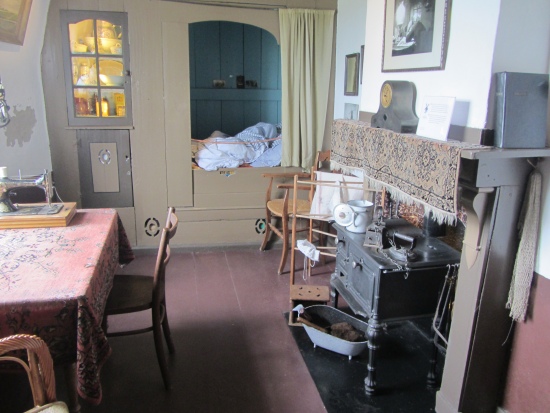
Museum Windmill Nederwaard Living Room
|
Once in the city, we returned to
Duonita to warm up, drink hot tea, and give Rex the chance to whizz around the boat with a hoover. He can become a domestic god at times. We used to joke about how the Dutch were always meticulously cleaning and polishing their boats, cars and almost everything; now Rex was actually trying to compete. Incredibly he refused a beer, so he had really caught the cleaning bug badly.
We visited the little restaurant, Eetcafe de Passant, just down the road from the boat, for some food. Initially we sat down outside, but the wind was getting up and dark clouds were scudding in and congregating, so we nipped inside the restaurant. It was empty, but the head waitress asked if we had reserved a table. No we hadn't. "You can have that table there," she said pointing to a table for two. But there were three of us. Sadly all the other tables were reserved. Just then a woman walked in with her partner, and she immediately spotted our dilemma, and said we could have her reserved table that could accommodate three people. She and her partner would take the table for two. That was ever so kind of her, especially so since she had given us the best table in the house with an excellent view over the Engelenburgerbrug.
We enjoyed a lovely meal, and towards the end, Meryl spotted the lady who had offered her table, and thanked her profusely. The woman was very chatty and confident, with a warm personality. She appreciated our attempts to speak Dutch, and she adored the English accent, even grasping the concept of a northern accent. We chatted for a short while, interspersed with hoots of laughter from the woman, before she announced, "Excuse me, I need to have a pee before I smoke. Excuse me, I think I have drunk too much. Have a good evening and enjoy the rest of your holiday." She disappeared off with echoes of laughter following her down the steps.
The restaurant had low, gentle English music playing in the background. For some reason, it suddenly burst forward with "So This is Christmas" by John Lennon. Rex and one of the waitresses immediately fell into fits of laughter, and soon the whole restaurant was giggling. The Dutch have a mischievous sense of humour.

